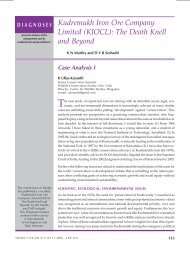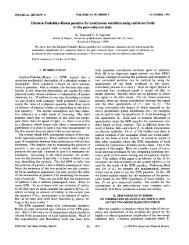Analysis of Fluorescence Decay by the Nonlinear Least Squares ...
Analysis of Fluorescence Decay by the Nonlinear Least Squares ...
Analysis of Fluorescence Decay by the Nonlinear Least Squares ...
You also want an ePaper? Increase the reach of your titles
YUMPU automatically turns print PDFs into web optimized ePapers that Google loves.
W using excitation function A. The following values were<br />
used for <strong>the</strong> parameters in Eq. (15): Al = 10.0, rI = 0.1 ns,<br />
A2 = 1.0, and r2 = 2.0 ns. Ten sets <strong>of</strong> excitation and<br />
emission data were simulated for each W. Deconvolution<br />
analysis <strong>by</strong> method I produced consistently better results<br />
(i.e., A1/A2, and rI were closer to <strong>the</strong> values used in<br />
simulation) compared with method II for all W; however,<br />
for W < 1 x 104, <strong>the</strong> analysis <strong>by</strong> both <strong>the</strong> methods gave<br />
chi-square values which are nearly equal. Fig. 2 shows <strong>the</strong><br />
variation <strong>of</strong> <strong>the</strong> chi-square values obtained in <strong>the</strong> analysis<br />
<strong>by</strong> method I and II as a function <strong>of</strong> W. The data analysis <strong>by</strong><br />
ei<strong>the</strong>r method gave a chi-square value which increased<br />
with increasing W, <strong>the</strong> increase being steeper in <strong>the</strong> case <strong>of</strong><br />
method II. This indicates that <strong>the</strong> numerical integration<br />
proposed here is better than <strong>the</strong> trapezoidal approximation<br />
for handling precision data.<br />
Methods I and II were <strong>the</strong>n compared with <strong>the</strong> analysis<br />
<strong>of</strong> data simulated for various values <strong>of</strong> <strong>the</strong> short lifetime<br />
component. The simulation parameters were as follows:<br />
W = 105, A2 = 1.0, r2 = 2.0 ns, and AI = 10.0. ,r was varied<br />
from 0.02 to 1.0 ns. For each value <strong>of</strong> rI ten sets <strong>of</strong><br />
excitation and emission data were simulated. These simulation<br />
data were analysed and Fig. 3 A shows <strong>the</strong> variation<br />
<strong>of</strong> <strong>the</strong> chi-square values obtained <strong>by</strong> both <strong>the</strong> methods. Fig.<br />
3 B shows <strong>the</strong> ratio (rI/rI) obtained <strong>by</strong> both <strong>the</strong> methods,<br />
IT being <strong>the</strong> average <strong>of</strong> ten optimised values <strong>of</strong>TI obtained<br />
in <strong>the</strong> analysis. It is found that method I is able to extract<br />
<strong>the</strong> short lifetime component more correctly and with<br />
better values for statistical test parameters. However, for<br />
T1 > 0.5 ns both <strong>the</strong> methods are equally efficient.<br />
The randomness <strong>of</strong> <strong>the</strong> distribution <strong>of</strong> weighted residuals<br />
is usually checked <strong>by</strong> <strong>the</strong> calculation <strong>of</strong> reduced chisquare<br />
and o<strong>the</strong>r test parameters. It is instructive to<br />
examine also visually <strong>the</strong> distribution <strong>of</strong> <strong>the</strong> weighted<br />
w<br />
I I()<br />
3-0 -<br />
201-<br />
1-0 _<br />
0-0<br />
103 104<br />
s _A _R<br />
10w<br />
W<br />
10°<br />
FIGURE 2. Variation <strong>of</strong> <strong>the</strong> values <strong>of</strong> chi-square obtained <strong>by</strong> method I<br />
(o) <strong>by</strong> method II (x) for various values <strong>of</strong> W. See text for details.<br />
966<br />
4 I]<br />
I I<br />
_S!~~I<br />
0<br />
1 5 _ B<br />
*-0<br />
1-0<br />
wI<br />
X 1-4<br />
I<br />
C) 10<br />
x<br />
x<br />
-90 6 K K<br />
x x<br />
x<br />
x<br />
0<br />
0.0<br />
II<br />
0-5<br />
T. (ns)<br />
1-0<br />
A<br />
FIGURE 3. Plot <strong>of</strong> optimised<br />
values (average <strong>of</strong> ten) <strong>of</strong> <strong>the</strong><br />
short lifetimes (rl) (plotted as<br />
ll/r1, top) and chi-square (bottom)<br />
obtained in <strong>the</strong> analysis <strong>of</strong><br />
data <strong>by</strong> method I (o) and <strong>by</strong><br />
method 11 (x) versus Tx. bt = 50<br />
ps for all simulated data. See text<br />
for details.<br />
residuals. Fig. 4 shows a typical display <strong>of</strong> <strong>the</strong> weighted<br />
residuals obtained <strong>by</strong> methods I and II in <strong>the</strong> analysis <strong>of</strong><br />
simulation data using Eq. (11) for excitation function<br />
(cr = 0.2 ns, m = 1.2 ns, and W= 1 x 105), and Eq. (15)<br />
for I(t) (AI = lO.O,T1 = 0.1 ns,A2 = 1,andT2 = 2ns). The<br />
simulated excitation data, emission data, and fitted emission<br />
data (method I) are shown in Fig. 4. In this case <strong>the</strong><br />
emission data was not normalized and <strong>the</strong> peak count<br />
was -1.2 x I05. The distribution <strong>of</strong> <strong>the</strong> weighted residuals<br />
in <strong>the</strong> region dominated <strong>by</strong> <strong>the</strong> short lifetime component is<br />
more acceptable in Fig. 4 B than in Fig. 4 C. Deconvolution<br />
<strong>by</strong> method I produced <strong>the</strong> following results: AI = 10.0,<br />
Tr = 0.101 ns, A2 = 1.01, T2 = 2.00 ns, (reduced) chisquare<br />
= 1.17, Durbin-Watson parameter (DWP) = 1.90,<br />
standard normal variate <strong>of</strong> runs test (Z) = -0.05, and<br />
percentage <strong>of</strong> weighted residuals between -2 and + 2<br />
(PER) = 95.09. Deconvolution <strong>by</strong> method II produced <strong>the</strong><br />
following results: AI = 9.44, T1 = 0.106 ns, A2 = 1.01, T2 =<br />
2.00 ns, chi-square = 1.41, DWP = 1.59, Z = 1.58, and<br />
PER = 92.77.<br />
In <strong>the</strong> simulations described earlier <strong>the</strong> time interval was<br />
chosen to be 50 ps. The conclusion that <strong>the</strong> performance <strong>of</strong><br />
method I is better than method II when <strong>the</strong> short lifetime<br />
in <strong>the</strong> decay equation is comparable to bt is independent <strong>of</strong><br />
<strong>the</strong> value <strong>of</strong> bt used in simulations. The computation time<br />
required for method I or method II depends upon <strong>the</strong><br />
number <strong>of</strong> iterations required for convergence, which need<br />
not be equal. On <strong>the</strong> average it is observed that method I<br />
requires -10% more computer CPU time (Cyber 170/<br />
730) than that required for method II. However, <strong>the</strong>re<br />
were several cases in which method I required less time<br />
than method II because <strong>of</strong> convergence at a lower interation<br />
number.<br />
The method proposed here has also been used in <strong>the</strong><br />
analysis <strong>of</strong> experimental fluorescence data <strong>of</strong> standard<br />
samples obtained <strong>by</strong> time-correlated single photon<br />
counting technique. In comparison with <strong>the</strong> simulation<br />
data <strong>the</strong> quality <strong>of</strong> <strong>the</strong> experimental data was poor because<br />
<strong>of</strong> system errors, especially <strong>the</strong> wavelength response <strong>of</strong> <strong>the</strong><br />
photomultiplier which needed to be corrected in <strong>the</strong> analysis<br />
<strong>by</strong> introducing a shift parameter. In spite <strong>of</strong> this, it is<br />
generally observed that method I generates results with<br />
BIOPHYSICAL JOURNAL VOLUME 54 1988
















